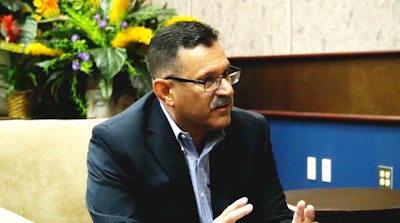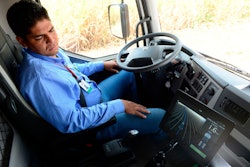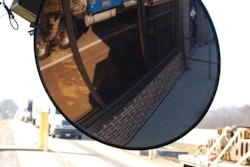 Ray Martinez, pictured during an interview with CCJ staff in March. Martinez spoke with CCJ via phone on Tuesday.
Ray Martinez, pictured during an interview with CCJ staff in March. Martinez spoke with CCJ via phone on Tuesday.Ray Martinez, who has helmed the Federal Motor Carrier Safety Administration since February, spoke with CCJ in a half-hour phone interview Tuesday, discussing topics ranging from carriers’ difficulties in hiring and retaining drivers, the potential for hours of service changes, the coming of autonomous vehicles, the industry’s transition to ELDs and the direction he’d like to see the agency move under his watch.
“I’d like to be able to say a year from now that the industry has noted a difference in posture from the previous three years or five years from this agency,” he said. “That we are more receptive to new ideas. That we listen better. That we’re more cooperative with industry and trying to work together to make the roadways safer.”
Many of his conversations with industry stakeholders in his five months on the job have centered on hours of service regulations, he said.
As he’s noted publicly in the past, Martinez says he’s open to exploring regulatory reforms around hours of service, telling CCJ on Tuesday that he hopes to kick off dialogue on tweaking hours regs in the coming months. “That’s what I keep hearing — ‘we need some flexibility,'” he said. “I’m hoping in the next few months we can move forward with some thoughts about how that might make sense. I think it’s worth revisiting the existing hours of service and looking at providing greater flexibility.”
Chief topics for hours of service reforms include reevaluating the 30-minute break standardized in 2013 and allowing drivers to split their 10-hour off-duty period into segments. The 30-minute break is “one area across the board we’ve heard complaints about,” Martinez said. “Why wouldn’t we look at that? The other issue is to revisit the issue of split sleeper to say what kind of flexiblity can be added there?”
Though the industry is still adjusting to the implementation of electronic logging devices, Martinez said he sees potential for the devices to be a catalyst toward holding shippers and receivers accountable for excessive detention time — particularly in light of the industry’s alarm over the need for more drivers. “We believe there’s a driver a shortage, and there’s a lot of reasons why that occurs. Some of it has to do with inefficiency in the supply chain. How can you have a driver shortage and have detention times that go into the hours? That’s a terribly inefficient use of a valuable resource,” he said.
ELDs, he said, could highlight “what a significant issue” detention time is. “I believe it’s going to bring that issue to the fore.”
Autonomous vehicles and crash numbers
Acknowledging that truck and bus crash numbers, and injuries and fatalities therefrom, have been in the rise in recent years, Martinez said he hopes during his tenure as FMCSA’s administrator that the numbers trend downward again. Employing new technologies, such as those that are building blocks toward greater autonomy, could be key in that goal, he says.
“I don’t have to tell people in this industry who drive for a living that the landscape out there is dangerous, in large part because of bad driving behaviors by passenger vehicles. I’m hoping that — certainly in the three years that I’m here, and hopefully longer — that we will see a better integration of new technologies that will help crash prevention. I would hope to see safety numbers moving in the right direction. I think that’s an important piece.”
Martinez said he can’t make predictions about when or even if fully automated vehicles have real-world practicality. But the technologies that underpin autonomous vehicles are “going to have a great impact on safety,” he said.
The U.S. DOT as a whole “is very attuned” to autonomy, he said. The DOT later this year plans to unveil its most detailed roadmap to date, dubbed the AV 3.0 report, in addressing automated vehicle development and deployment. “We have worked with all the other modes to clarify what the federal government’s posture should be,” he said. “We want to make sure we don’t inhibit technology, research and testing. We want to make sure that that’s done safely, but we certainly don’t want to inhibit that.”
Overhauling CSA
FMCSA is planning a “robust listening session” for the fall to address reforms to the agency’s Compliance, Safety, Accountability program, Martinez said. The date has not yet been set, but Martinez said he hopes to glean as much input as possible from industry stakeholders to help address the future of the safety program. The agency is in the midst of reforming the program based on recommendations from the National Academies of Science, who last year recommended sweeping changes to the carrier rating program. The agency announced last month it would begin testing a new scoring system this fall.
Martinez encouraged participation in the listening session, as well as other chances to provide the agency with feedback. “We’re not going to progress without robust industry participation,” he said. “We can take criticism, constructive criticism. That’s good; that’s the way this is supposed to work. But if we move forward with proposals that you agree with, what I would ask is that you voice your support when we do that. If you like it, don’t assume it’s going to get done. These are put out as proposals and they’ll never get done unless there is support from the regulated community.”











